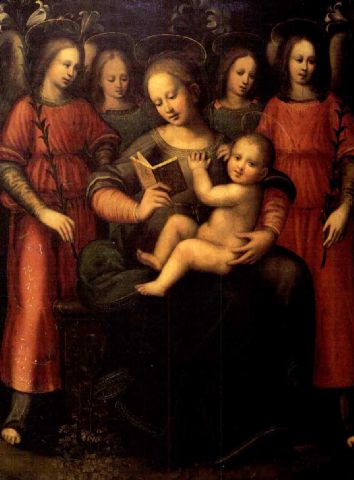Sister Nelli gets her due
Orate pro pictoria - Prayer for the painter
by Jane Fortune
She came from a wealthy family with a street in Florence named after them. She hobnobbed with the famous painters of her day. She painted prodigiously, but only three paintings have been authenticated. Today, she remains virtually unknown. Who was she?
She was a woman at a time when works of art by women were considered non importante. She was the first known female painter of Florence when the field was dominated by men. She was a Domenican nun. She was Suor Plautilla Nelli, an artist of much note in her time, and one who is finally getting her due.
Suor Plautilla Nelli (1523-1588) was born into a noble Florentine family. She entered the convent of Santa Caterina di Siena in Florence (which taught painting and sculpting of terracotta figures) in 1538, at the age of 14, and eventually became its prioress, several times. The convent, founded by Camilla Bartolini Rucellai in 1496, was ‘run’ by the friars of San Marco, the most famous friar being Savonarola. The convent (now destroyed), located in Piazza San Marco, was supposedly annexed into the Galleria dell’Accademia in 1853 and was briefly part of the Accademia delle Belle Arti. According to noted Nelli expert, Catherine Turrill, many of the nuns at Santa Caterina were daughters of Florentine artisans, and the convent was unrivaled throughout Italy for the ‘number and significance’ of its nun-artists.
Nelli’s family came from the Mugello, as did the Medici. Her father was a fabric merchant. The New Sacristy it the Church of San Lorenzo is located where the Nelli homes originally were built. Via del Canto de’ Nelli, near San Lorenzo, as named after the family and still exists today. And, Niccolo Machiavelli’s mother was Bartommea Nelli.
Suor Plautilla Nelli studied and copied works primarily by Fra’ Bartolomeo, Bronzino and Andrea del Sarto. Fra’ Bartolomeo left his drawings to his pupil, Fra Paolino, who, upon his death, left them ‘with the nun that painted,’ according to Vasari. She had many patrons (many were women) and did large alter pieces, small devotionals and miniatures, most which were lost. Nelli, with her sister, Suor Petronilla, (who wrote a biography on Savonarola, still in print), together painted a few illuminations for choral books. Suor Plautilla supposedly did the drop capital (the large letter that beginse ach page), usually surrounded by a figure of a nun. A few of these exquisite illuminations, assigned to Nelli, are in the library at Museo di San Marco and the Biblioteca Marucelliana, not on public display.
In her time she was widely praised and received many important commissions, but today, only four of her paintings have been authenticated. The Lamentation with Saints in the Refectory of San Marco Museum is her most famous public work, which expresses a rare raw emotional grief of Christ’s death, depicted through the red eyes and visible tears of the figures. Her Last Supper originally hung in the refectory of her convent, but, since 1853, it is in the Refectory of Santa Maria Novella. The Pentecost in the Church of San Domenico in Perugia is her third recognized work. In 1985, another painting was ‘confirmed’ of Madonna and Child with St. Catherine and Two Angels (Lo Sposalizio Mistico di Santa Caterina) in the Galleria Collegiata in Empoli. Also, two drawings in the Gabinetto Disegni e Stampe degli Uffizi have hand written attributions—Head of a Woman and Kneeling Woman. With so few authentications, it is interesting that in 1550 Vasari, in his Lives of the Most Excellent Painters, Sculptors and Architects, writes of Nelli, ‘…and in the houses of gentlemen throughout Florence, there are so many pictures, that it would be tedious to attempt to speak of them all.’ Where her paintings are today, remains a mystery.
According to Catherine Turrill, Nelli was probably buried inside her convent of Santa Caterina di Siena, in a general tomb with the other prioresses of the convent. But neither the convent, nor the church connected to it, exists today. The structures were replaced by the Tosco-Emilian Regional Military Command, so another question is what actually happened to the burial site after the convent was closed in the early 19th century, to be eventually demolished and built over.
Florence, so known for its Renaissance art, has overlooked Nelli, its first acknowledged woman painter, as has most of the art world. Why? Perhaps because she did not have the advantage of studying. Or it could be that because of her profession, she represented all her figures with female characteristics, and was thus initially considered a superfluous amateur as an artist. Well, not anymore.
The Florence Committee of National Museum of Women in the Arts, founded in 2003, advocates for the preservation, conservation and restoration of works by past and present Italian women artists in Florence Museums. It has decided to bring Suor Plautilla Nelli and her talent to the public fore by sponsoring the restoration of her painting Lamentation with Saints (Compianto con Santi), housed in the Refectory of Museo di San Marco, which is generally overlooked by the visitors to the Museum. On Oct. 23, 2006, the Florence Committee will ‘unveil’ Nelli’s Lamentation in the Refectory of San Marco Museum at a private event.
The painting can be viewed by the public starting Oct. 24.
From THE FLORENTINE
Special thanks to the editors of IDI for posting this article.
